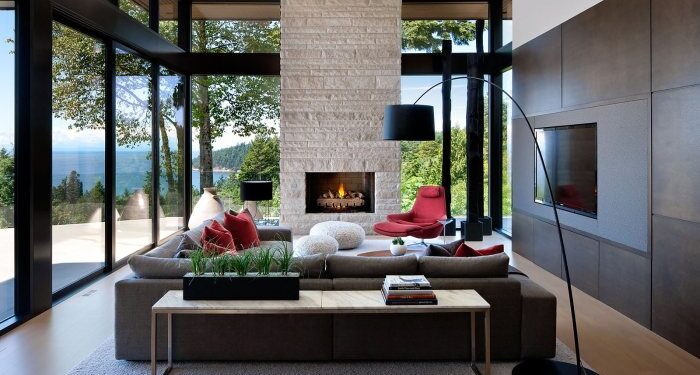Modern contemporary interior design sets the stage for this enthralling narrative, offering readers a glimpse into a story that is rich in detail and brimming with originality. From sleek lines to innovative materials, this design style encapsulates a perfect blend of modern aesthetics and functional elegance.
As we delve deeper, we'll explore the defining features, color palettes, furniture layouts, and lighting choices that make modern contemporary interior design a true masterpiece of the modern age.
Definition of Modern Contemporary Interior Design
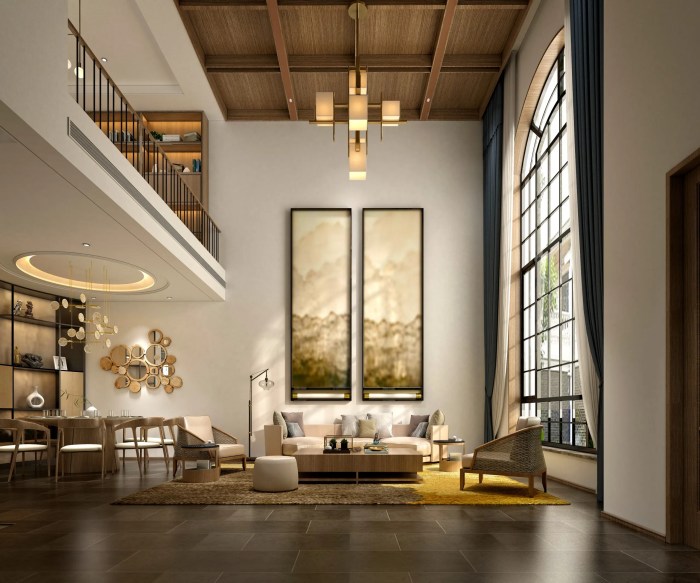
Modern contemporary interior design is a style characterized by clean lines, minimalism, and a focus on functionality. It incorporates elements from both modern and contemporary design styles to create a sleek and sophisticated look.
Characteristics of Modern Contemporary Interior Design
- Neutral color palette with bold accents
- Use of natural materials like wood, stone, and metal
- Sleek and clean lines in furniture and architecture
- Open floor plans with plenty of natural light
- Minimalistic approach with clutter-free spaces
Differences from Other Interior Design Styles
- Modern contemporary design combines elements from both modern and contemporary styles, whereas modern design refers to a specific period in design history.
- Contemporary design is more fluid and ever-changing, while modern contemporary design has a more timeless appeal.
- Traditional design tends to be more ornate and decorative, while modern contemporary design focuses on simplicity and functionality.
Elements Found in Modern Contemporary Interiors
- Large windows and open spaces to maximize natural light
- Sleek and simple furniture with clean lines
- Minimalistic accessories and decor pieces
- Mixing of textures and materials for visual interest
- Incorporation of technology and smart home features
Color Palette and Materials
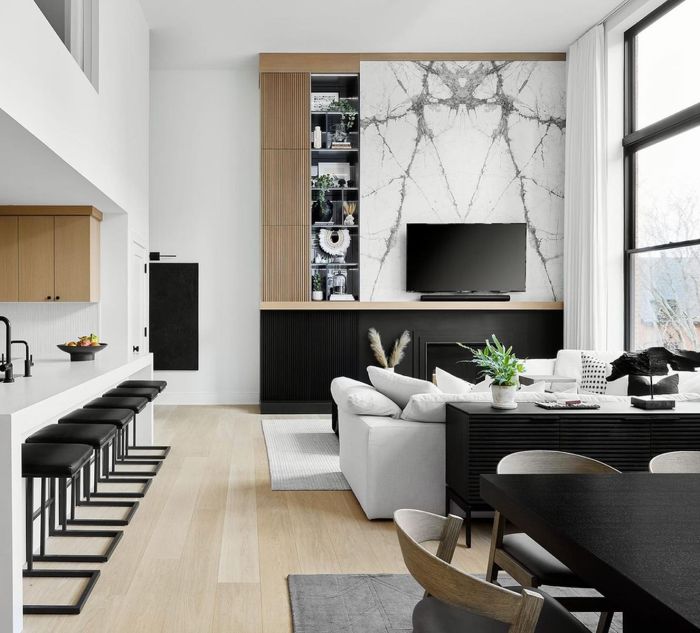
When it comes to modern contemporary interior design, the color palette and materials play a crucial role in defining the overall aesthetic of a space. From trendy color schemes to the use of innovative materials, these elements work together to create a sleek and sophisticated look.
Popular Color Schemes
In modern contemporary interior design, popular color schemes often revolve around neutral tones like white, beige, gray, and black. These colors provide a clean and minimalist backdrop that allows other design elements to stand out. Additionally, pops of bold and vibrant colors may be incorporated through accent pieces or artwork to add visual interest and personality to the space.
Materials: Glass, Metal, and Concrete
Glass, metal, and concrete are commonly used materials in modern contemporary design. Glass is favored for its transparency and ability to reflect light, creating a sense of openness and airiness in a space. Metal accents, such as stainless steel or brushed nickel, add a touch of industrial chic and can be used for furniture, fixtures, and decorative elements.
Concrete, with its raw and unfinished look, brings a sense of urban sophistication and modernity to interiors.
Impact of Materials on Space
The choice of materials can greatly impact the overall look and feel of a space in modern contemporary interior design. Glass and metal elements can contribute to a sleek and polished aesthetic, while concrete can add a touch of edginess and urban flair.
By carefully selecting and combining these materials, designers can create a harmonious balance between modernity and warmth, resulting in a space that is both stylish and inviting.
Furniture and Layout
In modern contemporary interior design, furniture plays a crucial role in defining the style and functionality of a space. The furniture pieces are typically sleek, clean-lined, and minimalist, with a focus on both form and function.
The layout of furniture in a modern contemporary space is carefully planned to create a sense of openness and flow. Symmetry and balance are key principles in arranging furniture to achieve a harmonious and visually appealing aesthetic.
Furniture Styles in Modern Contemporary Interiors
- Minimalist furniture with clean lines and geometric shapes.
- Use of materials like glass, metal, and wood with a natural finish.
- Statement pieces that serve as focal points in the room.
Furniture Placement and Layout
- Furniture placement should prioritize functionality and comfort while maintaining a sense of openness.
- Utilize a mix of furniture sizes and shapes to create visual interest and balance in the space.
- Consider the flow of traffic and ensure that there is enough space for movement around furniture pieces.
Selecting Furniture for a Modern Contemporary Theme
- Opt for furniture with clean lines, minimal ornamentation, and a neutral color palette.
- Choose pieces that are both stylish and functional, with a focus on quality craftsmanship.
- Consider the scale of furniture in relation to the size of the room to avoid overcrowding or overwhelming the space.
Lighting and Accessories
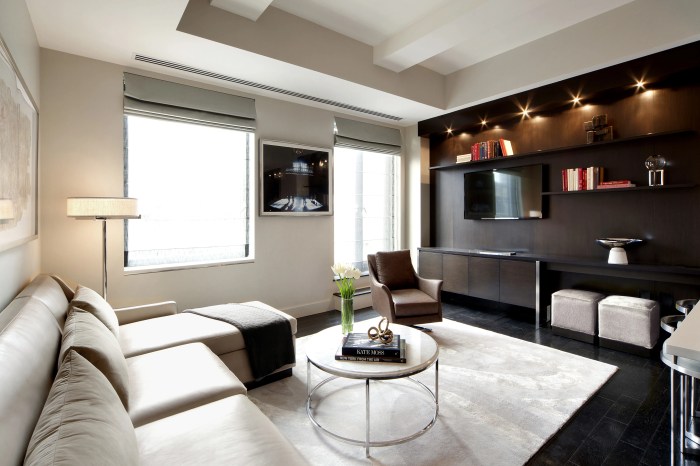
Lighting and accessories play a crucial role in modern contemporary interior design, enhancing the overall aesthetic and functionality of a space.
Importance of Lighting
Proper lighting is essential in modern contemporary spaces as it can create different moods, highlight design elements, and improve the overall ambiance. It is a key factor in making a room feel welcoming and visually appealing.
Enhancing Design with Lighting Fixtures
Lighting fixtures such as pendant lights, track lighting, and recessed lighting can be used to enhance the design elements in a room. For example, strategically placed wall sconces can highlight artwork or architectural features, while statement chandeliers can serve as a focal point in a dining area or living room.
Accessories for Modern Contemporary Design
- Minimalist artwork: Abstract paintings or sculptures can add a touch of sophistication to a modern contemporary space.
- Textured rugs: A plush rug with interesting textures can soften the sleek lines of modern furniture and add warmth to the room.
- Metallic accents: Accessories such as metallic vases, mirrors, or decorative objects can bring a touch of luxury and sophistication to a modern contemporary space.
- Geometric patterns: Pillows, throws, or decorative items with geometric patterns can add visual interest and complement the clean lines of modern furniture.
Final Thoughts
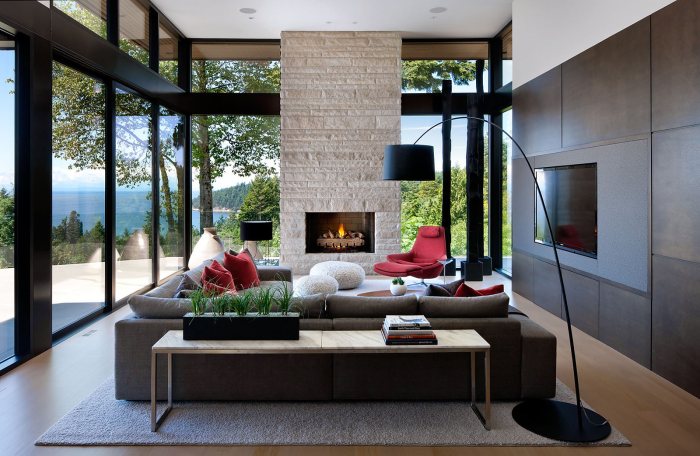
In conclusion, modern contemporary interior design paves the way for a harmonious fusion of form and function. With its emphasis on simplicity, clean lines, and innovative use of materials, this style offers a timeless appeal for those seeking a sophisticated yet practical living space.
Dive into the world of modern contemporary interior design and elevate your home to new heights of style and sophistication.
Common Queries
What sets modern contemporary interior design apart from other styles?
Modern contemporary design combines sleek lines, innovative materials, and a focus on functionality to create a unique aesthetic that is both stylish and practical.
What are some popular color schemes in modern contemporary interior design?
Neutral tones like white, grey, and beige are commonly used in modern contemporary interiors to create a clean and minimalist look.
How does furniture placement contribute to the overall aesthetic in modern contemporary design?
Strategic placement of furniture can enhance the flow of a space, highlight key design elements, and create a sense of balance and harmony in modern contemporary interiors.
Why is lighting important in modern contemporary spaces?
Lighting plays a crucial role in modern contemporary design by illuminating key features, creating ambiance, and enhancing the overall atmosphere of a room.
What accessories complement modern contemporary interior design?
Sleek and minimalist accessories like geometric sculptures, abstract artwork, and metallic accents can complement the clean lines and modern aesthetic of contemporary interiors.

